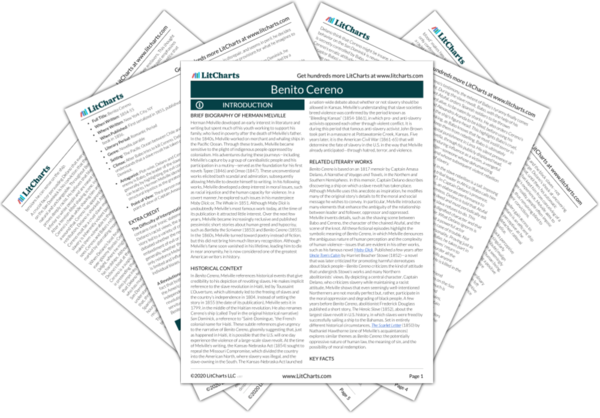Welcome to the LitCharts study guide on Herman Melville's Benito Cereno. Created by the original team behind SparkNotes, LitCharts are the world's best literature guides.
Benito Cereno: Introduction
Benito Cereno: Plot Summary
Benito Cereno: Detailed Summary & Analysis
Benito Cereno: Themes
Benito Cereno: Quotes
Benito Cereno: Characters
Benito Cereno: Symbols
Benito Cereno: Literary Devices
Benito Cereno: Theme Wheel
Brief Biography of Herman Melville

Historical Context of Benito Cereno
Other Books Related to Benito Cereno
- Full Title: Benito Cereno
- When Written: 1854-55
- Where Written: New York City, NY
- When Published: First serialized in 1855, published as a book in 1856.
- Literary Period: Romantic Period
- Genre: Novella, parable
- Setting: The Pacific Ocean between Chile and Peru in 1799
- Climax: After Babo tries to kill Cereno, Delano finally understands that a slave revolt has taken place on the San Dominick.
- Antagonist: Plot-wise, Delano and Cereno’s most dangerous enemy is Babo, the leader of the slave rebellion. More generally, by highlighting the evil consequences that slavery can lead to, Herman Melville identifies slavery, violence, and structural injustice as the greatest threats to society.
- Point of View: Third-person narrator, mostly following the point of view of Captain Amasa Delano
Extra Credit for Benito Cereno
The Difficulty of Interpretation. Although Benito Cereno contains clear ironic statements about protagonist Captain Delano’s racist views, the ambiguity at the heart of the short story led to a variety of critical interpretations. Critics have debated whether the revolting slaves should be seen as an embodiment of evil or as admirable revolutionaries—and, more generally, whether the story is pro- or anti-racist. Such debates only reinforce Melville’s understanding that human perception is limited and influenced by each reader or observer’s individual biases.
A Revolutionary Mind. Herman Melville was very proud of the fact that both of his grandfathers played an important part in the American Revolutionary War, which led to the country’s independence. In line with Melville’s fascination with this revolution, the idea that violent rebellion can put an end to servitude and oppression is one of the foundational themes in Benito Cereno.







